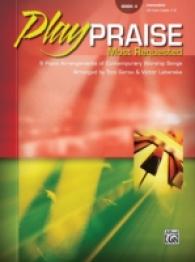Full Description
Janet Carr and Roberta Shepherd head up a new team of eminent authors for the second edition of this definitive text on neurological physiotherapy. In the first edition, the authors described a model of neurological rehabilitation for individuals with motor dysfunction based on scientific research in the areas of neuromuscular control, biomechanics, motor skill learning, and the link between cognition and action, together with developments in pathology and adaptation.
The new edition continues to advance this model while identifying and incorporating the many advances that have occurred in the last decade in the understanding and treatment of adults with neurological conditions, whether caused by accident or disease. Among these advances is the knowledge that the brain retains a plastic potential to reorganize, even in old and/or lesioned brains, and that neural plasticity can be influenced by task-related mental and physical practice in a stimulating environment. There is also an increasing body of knowledge related to the musculoskeletal system's adaptability and the need to prevent length and stiffness- related changes in muscle contractility, together with loss of aerobic fitness and endurance. There is an expanding body of clinical research that appears to support the model provided here.
The training guidelines outlined in Neurological Rehabilitation are based on biomechanical constructs and motor relearning research, applied to enhance brain reorganization and muscle contractility, and encourage functional recovery of the patient. It connects science and clinical practice enabling students and practitioners to develop their knowledge and use new clinical methods based on modern scientific understanding.
All chapters have been revised, some with the collaboration of five specialists who are engaged in high level scientific research and clinical practice
Biomechanical models are presented to provide a framework for action-specific training and exercise to improve performance
Clinical guidelines are science- and evidence-based
Emphasis is on new approaches to the delivery of neurological rehabilitation that increase the time spent in mental and physical activity, and the intensity of practice and exercise
Up-to-date referencing
Contents
Part One Introduction: Adaptation, Training and MeasurementChapter 1 The adaptive system: plasticity and recoveryChapter 2 Training motor control, increasing strength and fitness and promoting skill acquisitionChapter 3 Measurement
Part Two Task-Related Exercise and TrainingChapter 4 Standing up and sitting downChapter 5 WalkingChapter 6 Reaching and manipulationChapter 7 Balance
Part Three Body Function and Structure, Limitations in Activities and ParticipationChapter 8 Upper motor neuron lesionsChapter 9 Cerebellar ataxiaChapter 10 Somatosensory and perceptual-cognitive impairmentsChapter 11 StrokeChapter 12 Traumatic brain injuryChapter 13 Parkinson's Disease Chapter 14 Multiple Sclerosis
-

- 電子書籍
- 異世界女子、精霊の愛し子になる(5) …
-

- 電子書籍
- 実務家が押さえておきたい 事業承継対策…
-

- 電子書籍
- ペロずきんちゃん いちごがペロペロボワ…
-

- 電子書籍
- 勇者の孫と魔王の娘1 アルファポリスC…




